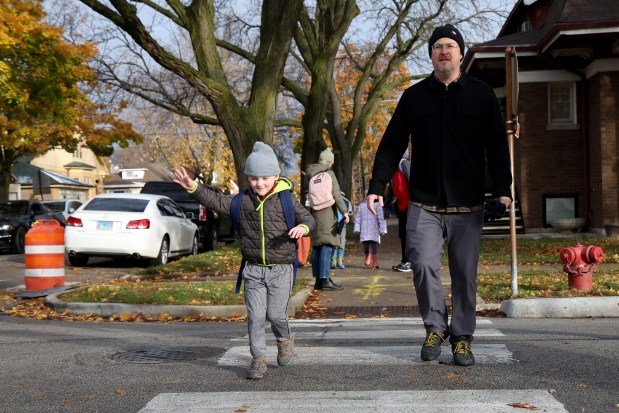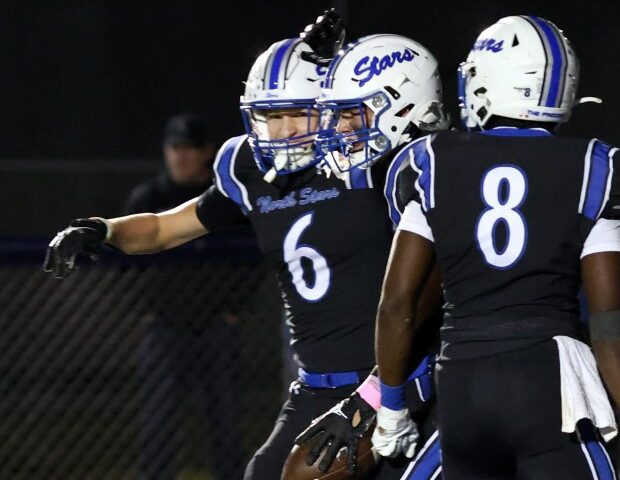Eager to finish tuning up bikes that they’d been learning how to fix since fall, the high school students in West Town Bike’s after-school program fell quiet when their instructor asked for a show of hands.
High school senior Christopher Garcia was one of three students who raised their hands when the instructor asked if they’d been hit by a vehicle while cycling.
The trio are among at least 2,860 Chicago pedestrians or cyclists ages 1 to 19 who’ve been hit by cars since 2021, according to a Tribune review of collisions logged by the Chicago Police Department.
Low-cost interventions that Chicago and other cities have added to select streets in the last two decades to make school routes safer for students to walk and bike to school have brought communities lasting benefits — and spurred a precipitous decline in injuries, experts say.
But local data suggests much work is to be done.
Traffic crashes accounted for 39 deaths, among pedestrians and cyclists under age 20 in Cook County between 2018 and 2022, the most recent years of Centers for Disease Control and Prevention mortality data available.
The Chicago Department of Transportation has ushered in a range of general pedestrian and cyclist safety projects in recent years, which the agency credits with allowing Chicago to outpace all other major cities in cycling growth.
Yet, a new initiative by the department focusing on schools last year was limited to only 10 sites among more than 600 schools in Chicago Public Schools.
!function(){“use strict”;window.addEventListener(“message”,(function(a){if(void 0!==a.data[“datawrapper-height”]){var e=document.querySelectorAll(“iframe”);for(var t in a.data[“datawrapper-height”])for(var r=0;r<e.length;r++)if(e[r].contentWindow===a.source){var i=a.data["datawrapper-height"][t]+"px";e[r].style.height=i}}}))}();
Given the preventable nature of crashes, far more safety initiatives are needed, students, advocates and parents who spoke with the Tribune said, as danger remains in at least some areas where the projects are completed.
Garcia bikes daily to Intrinsic Schools’ Belmont campus from his family’s home in Belmont-Cragin — one of the hot spots of car crashes involving youth pedestrians and cyclists that emerged in the Tribune’s analysis.
Becoming an avid cyclist gave him the freedom to explore the city, while learning bike maintenance through West Town’s program has made it affordable to do so — though the cost of riding a bike isn’t always monetary, he said.
“People don’t really notice cyclists. … They don’t even check their rearviews,” Garcia, 18, said, recalling being knocked off his bike after, he said, a car changed lanes directly into him. In relation to drivers, he said young cyclists should be aware: “It’s as if they’re a ghost.”
School route improvements
Every day, Carrie Bires and her third grade son walk on Long Avenue to Portage Park Elementary School, about a mile from where vehicles in separate incidents struck two teen cyclists, killing one, in the last year and a half. Improvements were made on the side street following the incidents. But Bires said she still sees drivers “fly through all of the stop signs” on Long. “I don’t think there’s a week that’s gone by that we haven’t been nearly hit by a car,” she said.
Unsettled by “senseless” traffic deaths, fellow Portage Park parent Pat Corcoran navigated Chicago Department of Transportation meetings to pitch improvements at the school attended by his two sons.
“I like walking to school because I love school,” Sully Corcoran, 5, said on a recent walk. Ren Gehrig, a neighbor in third grade, chimed in. “You can see friends, and it’s just fun.” But the extreme vigilance required to safely cross multiple alleys and intersections on the way to school isn’t lost on her. “I don’t think it’s fair,” she said. “Kids need to be extra safe.”
The traffic-calming projects at and near the kids’ school, completed in September, include a raised crosswalk at an intersection connecting Portage Park Elementary to the community’s namesake park. “Bump-outs,” in which the curb extends into the street at intersections, also decrease the time pedestrians are vulnerable to cars and require motorists making turns to slow down. The improvements on Long Avenue include bollards that prevent illegal parking from blocking sightlines, and clarify the contours of the road, in an area where the city’s typical grid is disrupted.
Now, Corcoran said he’d like to see more enforcement — noting that stop signs in some cities have cameras — and equitable improvements around the city, focused on hot spots. “On the North Side of the city (advocates have) been very successful. But that needs to be happening everywhere.”
The other school zone projects on CDOT’s agenda this year include similar interventions at Chicago Public Schools locations on the South, Southwest and West sides, at Bronzeville, Nash, Ruggles and Saucedo elementary schools and Kelly and Lindblom high schools.
A CPS spokesperson said that while the district hasn’t formally collected feedback from school communities yet, pedestrians seem to feel safer, and its recent, partial restoration of bus service will help ease traffic during pickup or drop-off times. The district remains committed to ensuring every student eligible has bus transportation, the spokesperson said.
‘Unwieldy and dangerous streets’
CPS parents and founding members of the community group, the Southwest Collective, Dixon Galvez Searle and Jamie Groth Searle, said it will take a lot more for many parents in hot spots to feel walking or biking their children to school is a viable option.
They live in Archer Heights, five blocks from where their daughter is in second grade at Richard Edwards Elementary, a dual-language neighborhood school of more than 1,200 students. But the Searles believe they’re nearly alone in walking and biking their child to school, having a rare route of exclusively side streets.
The school’s proximity to two major thoroughfares, 47th Street and Pulaski Road, makes walking and biking too dangerous for most other parents in the community, Galvez Searle said. “A lot of people feel compelled to get in the car for that two or three-block commute because they don’t want to have to cross the big, unwieldy and often dangerous street.”
On the larger Southwest Side, where freight traffic often traverses major roads, truck drivers have fatally struck two teen cyclists in separate incidents since 2021. Two pedestrians have been killed on Pulaski in the last year, Galvez Searle noted.
“We have not had the ability to add things like bump outs or even pedestrian refuge islands,” he said of concrete areas where people crossing a street on foot can safely pause midway between four lanes of traffic. “That’s really unfortunate, but the demand is there to add things that slow cars down and allow people to be out and about.”
Amid growth in bike lanes, gaps remain
As CDOT’s director of complete streets, David Smith has partnered with not only CPS but also ward offices and neighborhood groups on projects intended to calm traffic near schools. “Improving access and traffic safety around schools is a big priority for everybody,” he said.
But the total number of school-related projects implemented by the agency in the last decade is hard to quantify, Smith said, with some projects being as finite as improving a single intersection while others are expansive in scope.
Projects that improve school routes aren’t always billed as such, Smith added, noting that the recent Belmont Corridor project includes protected bike lanes and bus boarding islands that separate pedestrian, bike and vehicle commuters near Lane Tech High School. In general, the department has focused on creating pedestrian and bike-friendly connections among schools, parks, trails and transit, Smith said.
He credits CDOT’s efforts with a disproportionate decline in collisions. After a national spike in crashes during the height of the COVID-19 pandemic in 2021, Smith said crashes have fallen in Chicago by 27%, compared with a 5% drop nationally.
The new protected bike lane on Belmont Avenue earned praise from Alex Wilson, executive director of West Town Bikes, for improving access to the BMX trails at Clark Park, which he called “an attractor of youth on a very busy corridor.”
A pair of his apprentices gave mixed reviews of the status of improvements, or lack thereof.
Lane Tech High School senior David Harb, 17, said the new riverfront trail by the school is a highlight of his commute. But his ride to and from the Old Irving Park neighborhood also includes a dicey stretch of Elston Avenue, where he said potholes and construction crews blocking the bike lane often force cyclists into the same lane as cars. “Then you feel pressure to keep up with all the cars, and then it’s not very safe … and no one cares.”
Roberto Clemente Community Academy senior Armand Dunkines, 17, said he was struck by a driver who followed him through a turn, onto a stretch of North Avenue with no bike lane. “He didn’t give me enough space, enough time,” Dunkines said. “It hit my leg, it hit my back wheel.”
After taking a couple of days off and fixing his bent wheels, Dunkines kept on riding. But the driver’s response has stayed with him. “I felt this was also a little racial,” Dunkines said. “I asked him, ‘What’s going on, what happened?’ The guy said, ‘Me no speak español’ and then backed up and drove off.”
CDOT’s annual report flags “persistent disparities” that emerged in the agency’s analysis of crashes in 2023. Black Chicagoans were nearly four times more likely to be killed in traffic crashes, compared with all other residents, according to the agency’s analysis.
Design vs. driver behavior
“We’ve got a long way to go,” Smith said, alluding to Vision Zero. “The goal is to get to where zero people are impacted by traffic violence. That’s the North Star.”
While there’s a lot of focus on bad motorist behavior, the solution lies in ensuring safe driving isn’t a choice, said Nancy Pullen-Seufert of the National Center for Safe Routes to School. “We’re not just going to teach people to be safer drivers, and then that’s going to fix the problem,” she said, advocating for a focus on changes to the built environment instead.
“We know humans make mistakes. How can we build a system so that it doesn’t kill them?”
Doing so can improve everyone’s quality of life, according to Pullen-Seufert.
“Part of being a thriving community is having children, families feel safe, feel like they have opportunities to go to parks, go to schools, move around in their communities and take up space,” she said.
Students who spoke with the Tribune said they prize the freedom to explore, time with friends and physical exercise that they get from riding their bikes and walking to school. And they had no shortage of proposals to help keep them safe.
Garcia, the senior who lives in Belmont-Cragin, thinks more separation between cars and bikes, like on The 606 and Lakefront Trail, is ideal. “The infrastructure favors cars a lot, but also we should take into consideration cyclists. They’re people too and they can get hurt,” he said, later attaching a pair of blinking red lights to his bike, to ensure he was visible to cars on the ride home.
As a tall teen, with his face obscured by winter gear, Garcia blended in with adults as he hit the street. Perhaps drivers may have taken more care if it was obvious who he was: a student trying to get home safely after a long day of school.




